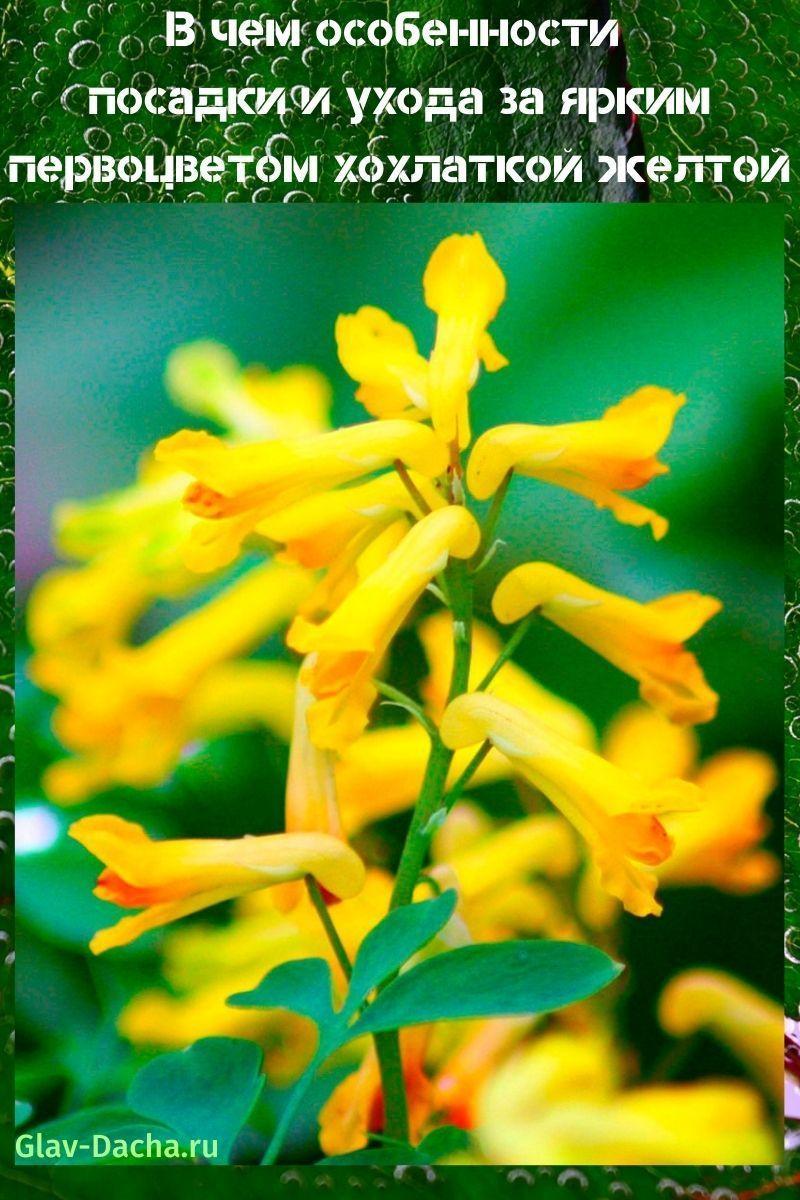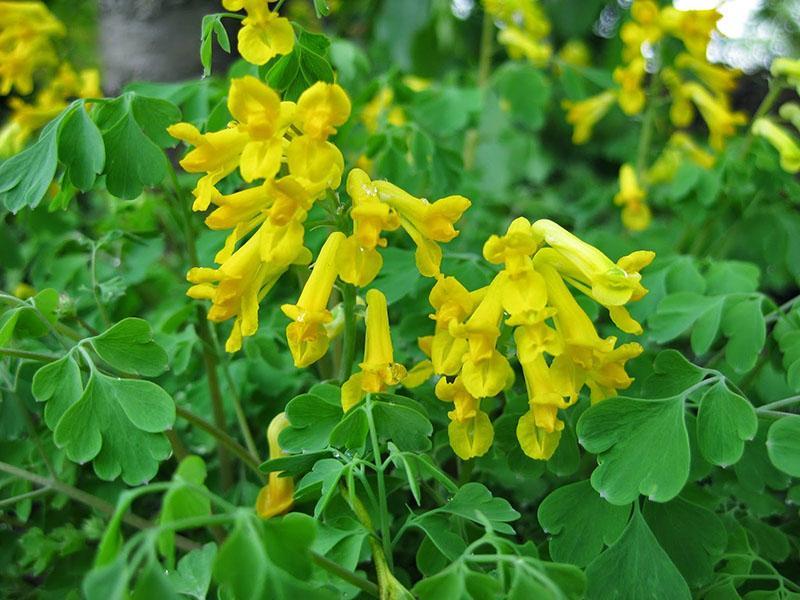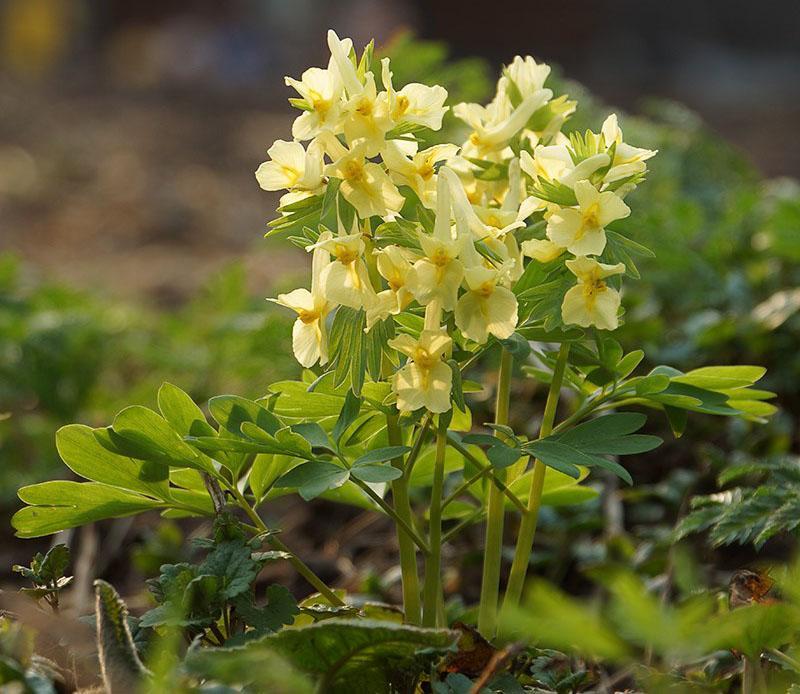What are the features of planting and caring for a bright yellow crested primrose
 Corydalis is a herbaceous perennial that belongs to the most popular garden plants. Planting and caring for corydalis yellow does not require much time and effort. The culture is distinguished by excellent frost resistance, strong immunity to diseases and pests, as well as visual appeal. This is what caused the popularity and demand for the yellow corydalis among summer residents who want to decorate the garden with bright, sunny yellow flowers.
Corydalis is a herbaceous perennial that belongs to the most popular garden plants. Planting and caring for corydalis yellow does not require much time and effort. The culture is distinguished by excellent frost resistance, strong immunity to diseases and pests, as well as visual appeal. This is what caused the popularity and demand for the yellow corydalis among summer residents who want to decorate the garden with bright, sunny yellow flowers.
Corydalis yellow - description of the plant

What does a yellow crested crested bird look like:
- The plant has a massive root system, consisting of many branched shoots that can penetrate into the ground to a depth of 50-80 cm.
- Perennial height - 35-45 cm, erect stems.
- The leaves are fern-like, lacy, large, divided in half or three, with triangular or rounded lobes, emerald green.
- Clusters of inflorescences are loose, cylindrical, consisting of 20-35 elongated flowers of a bright yellow hue.

- The flowers are formed from four small petals that curl outward. Near each flower there is a small leaf - a bract.
- After the end of flowering, fruits are formed - oblong "boxes" with small black seeds.
In the wild, the corydalis yellow belongs to the invasive weeds, since it easily adapts to almost any growing conditions and can grow both on rocky slopes and on limestones.
 That is why when planting and caring for corydalis yellow, even novice gardeners do not have any difficulties.
That is why when planting and caring for corydalis yellow, even novice gardeners do not have any difficulties.
Planting and caring for corydalis yellow
 You can start planting and caring for corydalis yellow from August to late September. The best place to grow a corydalis will be semi-shady areas that are as close as possible to the natural growing conditions of this plant.
You can start planting and caring for corydalis yellow from August to late September. The best place to grow a corydalis will be semi-shady areas that are as close as possible to the natural growing conditions of this plant.
Do not place perennials in direct sunlight - they can burn delicate leaves. The plant can be planted in the shade of trees, buildings or fences, but with even lighting.
Corydalis prefers neutral and slightly acidic soil, with deep groundwater. It should be well-drained with plenty of nutrients and organics. If the soil is too heavy, coarse sand should be applied before sowing.
Most often, the yellow corydalis reproduces by seeds, much less often the plant is grown from tubers.
Growing from seeds
 Corydalis from seeds is grown in the second half of summer or September. For this, you can use purchased seeds or collected from seed "bolls" of plants. Keep in mind that already 4-6 days after harvesting, the germination of seeds is significantly deteriorating, so you need to start planting them immediately after collection.
Corydalis from seeds is grown in the second half of summer or September. For this, you can use purchased seeds or collected from seed "bolls" of plants. Keep in mind that already 4-6 days after harvesting, the germination of seeds is significantly deteriorating, so you need to start planting them immediately after collection.
Seed planting algorithm:
- pour a nutritious substrate of sand and peat into a plastic container;
- spread the corydalis seeds on top of the substrate, previously aged for 2-3 days in a warm and dry place;
- sprinkle with a thin layer of sand;
- water the seeds;
- cover the container with glass or plastic wrap;
- Moisten the soil daily by spraying moisture from a spray bottle.
 After strong and healthy young shoots appear, the glass or plastic wrap can be removed and the seedlings transplanted to a permanent place in open soil. They need to be sealed in 7-14 cm planting holes - this depends on the size of the plant's tubers.
After strong and healthy young shoots appear, the glass or plastic wrap can be removed and the seedlings transplanted to a permanent place in open soil. They need to be sealed in 7-14 cm planting holes - this depends on the size of the plant's tubers.
It is advisable to transplant the grown seedlings into open ground not earlier than May-June of the next year, when the risk disappears return frosts, and the soil will warm up to at least + 17 °.
 When planting between the planting holes, be sure to leave a distance of 8-10 cm, since the yellow corydalis has a branched and massive root system.
When planting between the planting holes, be sure to leave a distance of 8-10 cm, since the yellow corydalis has a branched and massive root system.
The plant begins to bloom only 3-4 years after planting.
Corydalis reproduction
 Reproduction of corydalis yellow is most often carried out by dividing the rhizome. It is advisable to carry out such a procedure no more than once every 3-4 years, during the dormant period of the plant.
Reproduction of corydalis yellow is most often carried out by dividing the rhizome. It is advisable to carry out such a procedure no more than once every 3-4 years, during the dormant period of the plant.
 To do this, divide the corydalis rhizome in such a way that at least 1-2 growth buds remain on each of the parts obtained. Place the separated pieces in the planting holes 12-15 cm deep, leaving a distance of about 15 cm between them.
To do this, divide the corydalis rhizome in such a way that at least 1-2 growth buds remain on each of the parts obtained. Place the separated pieces in the planting holes 12-15 cm deep, leaving a distance of about 15 cm between them.
Corydalis care rules
 Corydalis yellow needs standard care to ensure its active growth and flowering. Perennials require regular watering, weeding and loosening of the soil, the introduction of complex mineral or organic fertilizers. It is also necessary to protect the plant from diseases and fight pests that have appeared.
Corydalis yellow needs standard care to ensure its active growth and flowering. Perennials require regular watering, weeding and loosening of the soil, the introduction of complex mineral or organic fertilizers. It is also necessary to protect the plant from diseases and fight pests that have appeared.
The beginning of spring is a period of active growth of the Corydalis. The soil is still moist from snow, so the plant does not need additional moisture. You need to water it only after the soil is completely dry.
Corydalis watering rules:
- When watering, it is very important to avoid stagnation of moisture in the soil. Excessive and frequent watering can cause root rot and plant death.
- After each watering, the soil around the flower bushes must be loosened. This will not only prevent the appearance of dry crust on the surface of the soil, but also improve the supply of nutrients and oxygen to the roots of the corydalis.
Corydalis yellow grows well and pleases with lush flowering and without the use of fertilizers.
 This unpretentious plant has enough nutrients contained in the soil. If desired, the corydalis can be fed organic fertilizers - humus or compost.
This unpretentious plant has enough nutrients contained in the soil. If desired, the corydalis can be fed organic fertilizers - humus or compost.
Preparing for winter
 After the flowering of the corydalis is completed, the wilted brushes and shoots of the plant must be completely cut off. The roots of the perennial are in deep soil layers, they are not afraid of frost, so the corydalis does not need additional shelter before winter.
After the flowering of the corydalis is completed, the wilted brushes and shoots of the plant must be completely cut off. The roots of the perennial are in deep soil layers, they are not afraid of frost, so the corydalis does not need additional shelter before winter.
Yellow Corydalis is a beautiful perennial plant that, with minimal maintenance, will become a bright accent of any personal plot. Sunny yellow primrose looks beautiful as an element of landscape design, decorate a flower bed, flower garden, alpine slides and rocky gardens.